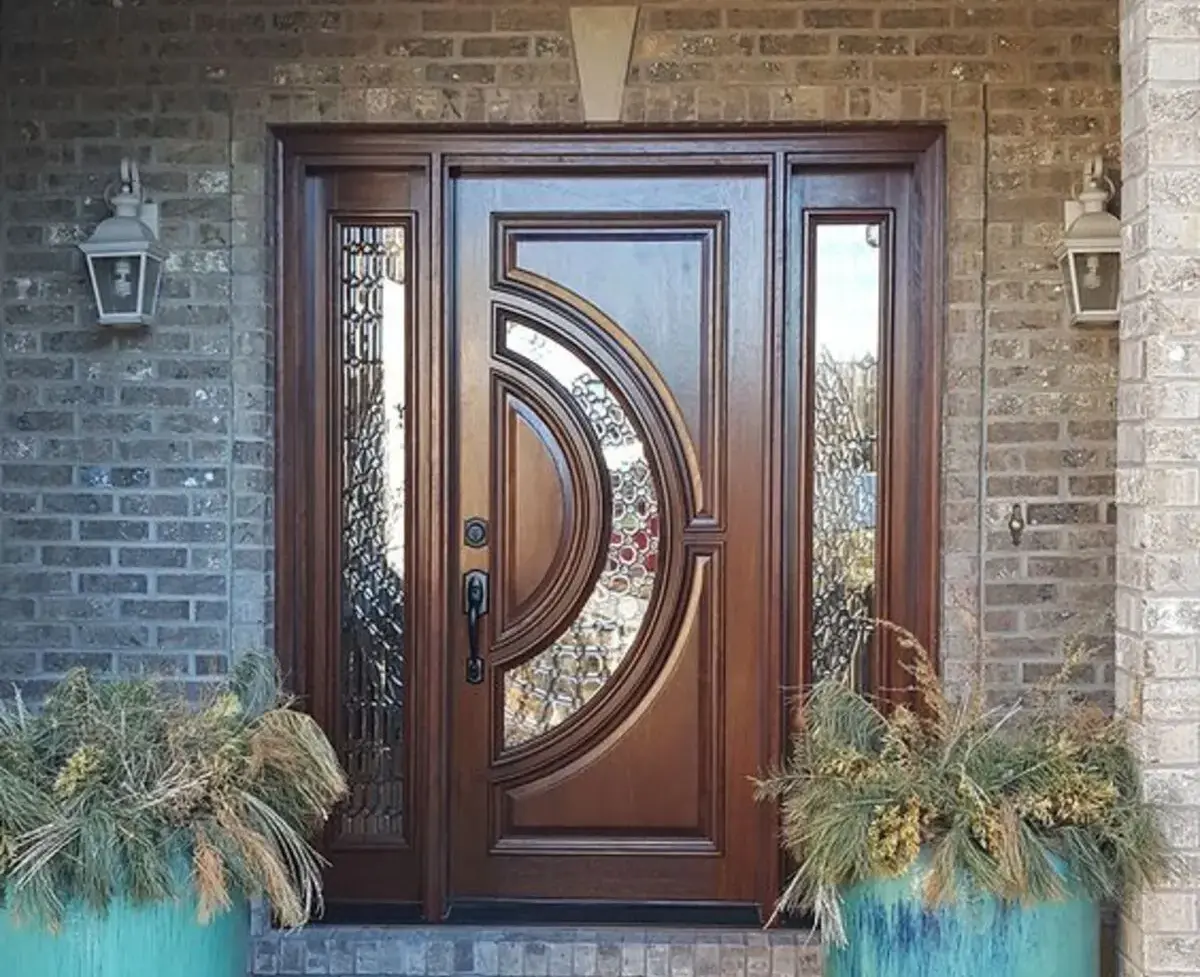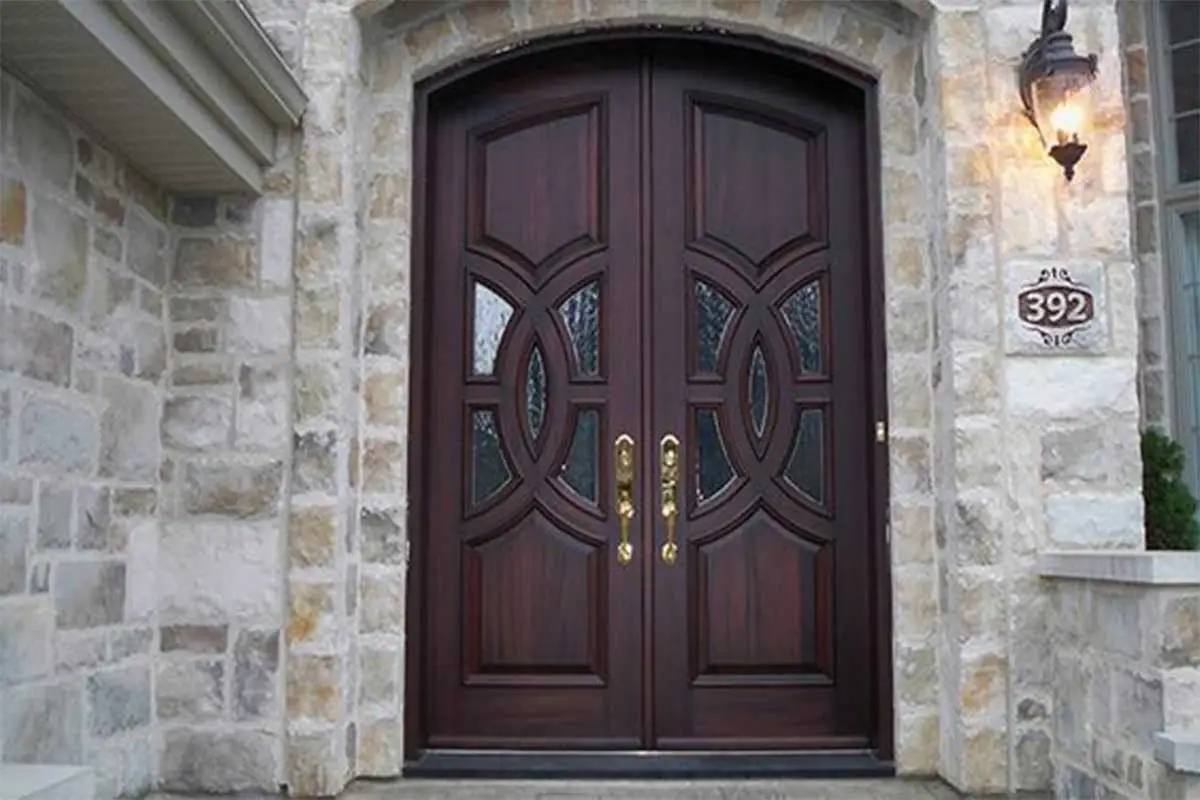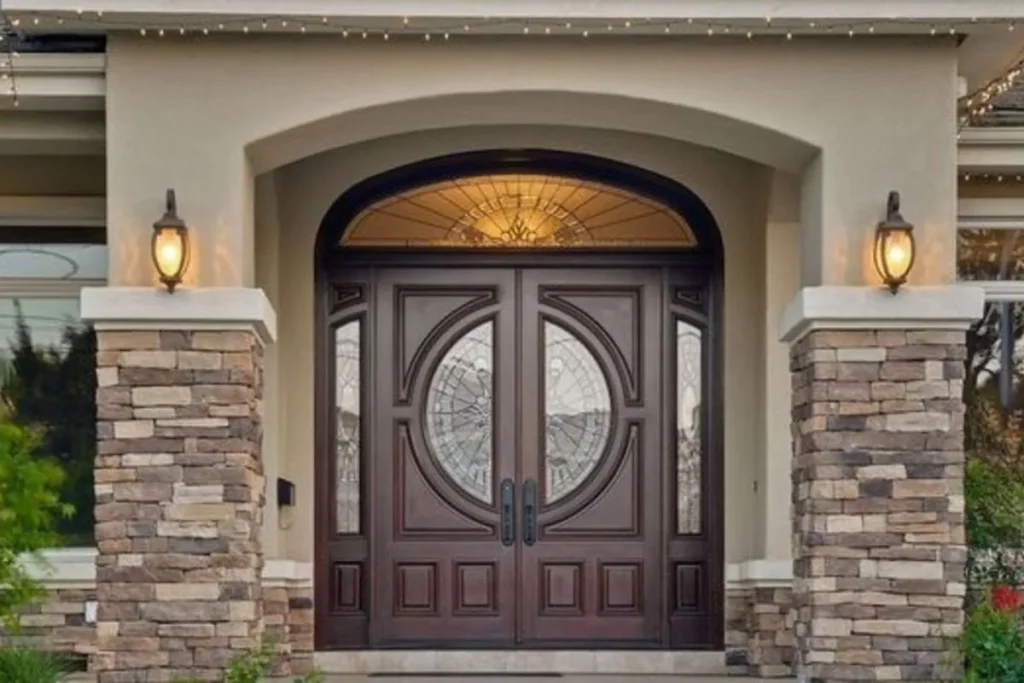Have you ever wondered why some wooden doors exude elegance, effortlessly tying a room’s aesthetics together? The secret lies in Choosing the Right Stain Color for your wooden doors, which blends art and science. This article which is written by Door4life, peels back the layers on selecting, applying, and maintaining the perfect stain, ensuring your doors look splendid and stand the test of time.
Understanding Different Types of Stains
Understanding what makes each stain type unique is paramount when embarking on a project, like choosing the right stain color for your wooden doors. Stains are not just about the color; they’re about the finish, durability, and ambiance they bring to your doors.
Table: Stain Type Comparison
| Stain Type | Characteristics | Best For | Dry Time | VOC Level |
| Oil-Based | Deep color penetration, enhances wood grain, durable finish | Traditional styles, rich color saturation, exterior applications | Longer (12-24 hours) | Higher |
| Water-Based | Easy cleanup with soap and water, dries faster, less odor | Modern & Eco-Friendly projects, cabinets, quick turnaround | Shorter (2-4 hours) | Lower |
| Gel | Thick consistency, minimizes drips, ideal for detailed work | Raised panels, carvings, and trim, preventing stain bleed-through | Moderate (4-8 hours) | Moderate |
| Pre-Conditioned Oil-Based | It contains a built-in conditioner to reduce blotchiness on absorbent woods. | Softwoods (pine), evening out stain absorption | Moderate (8-12 hours) | Varies (depends on brand) |
Characteristics of Oil, Gel, and Water-Based Stains
Oil-based stains are renowned for deep penetration into wood, offering a rich, durable finish. They enhance the wood’s natural beauty, making them a top choice for interior doors. Gel stains, on the other hand, are thicker, providing more control during application.
Read it: Residential Front Door Repair and its 16 signs in Atlanta
They are ideal for vertical surfaces and minimize drips and runs. Water-based stains stand out for their quick drying times and eco-friendliness. They provide a wide range of colors, making them suitable for modern stain colors for wooden doors.
The Role of Pigmentation in Wood Staining
Pigmentation is critical in wooden door stain color ideas, determining how the stain interacts with the wood’s natural grain and color. It’s not just about the hue but the consistency and coverage, especially when matching stain color to existing wood trim.
How Pigmentation Affects Color Depth and Consistency
The amount and type of pigment in a stain directly influence the color depth and consistency. High-pigment stains offer bold colors and obscure more of the wood grain, making them suitable for achieving darker tones. Conversely, light-pigmented stains are perfect for those desiring to enhance the natural wood grain, supporting the trend towards light vs dark stains for wooden doors.
Varnish vs. Lacquer: What’s Best for Your Door?
Choosing between varnish and lacquer is another decision that can impact the final look of your door. Varnish offers a durable and resistant finish against weather elements, making it ideal for front doors.
Read it: The Best Way to Update Your Doors in 2024? Affordable Door Refinishing!
Lacquer provides a smoother and more refined finish, with quicker drying times but less resistance to outdoor elements. Considering your door’s location and usage will guide you in choosing the right stain color for your wooden doors.
Choosing the Right Color for Your Door
Selecting the perfect stain color for your door combines art and science. It requires a keen eye for detail and an understanding of how colors interact with your home’s style and the door’s material. Let’s explore how to match the stain color with your wooden door’s natural beauty and the current trends in door colors.
Evaluating Wood’s Natural Color and Grain Pattern
Your wood door’s natural color and grain pattern are significant in staining. Recognizing these characteristics is the first step in choosing the right stain color for your wooden doors. Some woods have a pronounced grain pattern, lending themselves to darker stains that highlight their natural beauty, while others might benefit from lighter stains to make the space feel more open and airy.
Will Stain Color Change the Wood Grain?
- Enhancing natural grain: Applying stain can accentuate the wood’s inherent patterns, bringing out its unique features and adding depth to its appearance.
- Subduing inconsistencies: A well-chosen stain can minimize the look of knots or uneven grain, creating a more uniform appearance across the door.
Modern Stain Colors for Wooden Doors
- Greys and Smoky Tones: These colors offer a contemporary look that pairs well with modern home designs. They provide a neutral backdrop that complements both bright and subdued color schemes.
- Vibrant Mahogany: For those seeking warmth and richness, mahogany stains add a luxurious feel and enhance the door’s elegance.
- Classic Walnut: Walnut stains have a timeless appeal, perfect for traditional and contemporary doors. They offer depth and warmth without overwhelming the senses.
Light vs. Dark Stain for Wooden Doors: Making the Decision
- Visual space enhancement: Light stains can make a room feel larger and more open, ideal for smaller spaces. Dark stains, conversely, add a sense of luxury and depth, making them suitable for larger, well-lit areas.

- Maintenance considerations: Lighter stains show dirt and fingerprints less than darker stains, making them easier to maintain. However, darker stains can hide wear and tear better over time.
Table: Comparison of Light vs. Dark Stains for Wooden Doors
| Feature | Light Stain | Dark Stain |
| Visual Appeal | Creates a bright and airy feel, opens up small spaces | Adds drama and sophistication, emphasizes the door |
| Suitability for Wood Type | Well-suited for light woods (maple, ash, birch) | Well-suited for medium and dark woods (oak, cherry, walnut, mahogany) |
| Durability (for Exteriors) | It may require more frequent maintenance | Generally more weather-resistant |
| Matching with Trim/Flooring | Easier to match with lighter-colored trim/flooring | It can create a bolder contrast or a classic, dark-on-dark look |
How to Choose Stain Color & Transparency
Selecting the right stain color and its transparency is critical in achieving the desired look for your wooden doors. It’s not just about the hue; the finish’s opacity can significantly affect the wood’s appearance, blending seamlessly with your home’s interior or standing out as a bold statement piece.
Read it: Low-VOC refinishing solutions for Atlanta home
Let’s Explore the intricacies of stain transparency and how to harmonize your door’s color with the existing wood trim in your space.
Matching Stain Color to Existing Wood Trim
- Color coordination techniques: When choosing the right stain color for your wooden doors, consider the undertones in your existing wood trim. Opting for a stain with similar undertones can create a cohesive look, seamlessly integrating the door with the rest of the space.
- Contrast vs. complementary colors: Deciding between contrast and complementary colors depends on the desired visual effect. A contrasting stain can make the door stand out as a focal point, while complementary colors offer a subtle, unified appearance. Both strategies can enhance the room’s aesthetic depending on your design goals.
Preparing Your Door for Staining
Proper preparation is the cornerstone of achieving a flawless finish when staining your wooden doors. This preparatory phase ensures the stain adheres evenly and highlights the door’s natural beauty. Follow these essential steps to prepare your door for staining, laying the foundation for a stunning result.
Step One: Surface Cleaning and Sanding
Before any stain touches your door, starting with a clean slate is crucial. Removing dirt, grease, or existing finishes from the door’s surface. Use a mild detergent mixed with water for cleaning, then rinse with clear water and allow it to dry completely.
After cleaning, sanding is next. Start with medium-grit sandpaper to remove any rough spots and old finish, then progress to fine-grit sandpaper for a smooth, even surface. Remember to sand in the direction of the wood grain to avoid scratches that the stain could highlight.
Step Two: Applying Pre-Stain Wood Conditioner
After sanding, applying a pre-stain wood conditioner is vital, especially for softwoods like pine, which tend to absorb stains unevenly. The conditioner helps to prepare the wood, ensuring a uniform stain application.
Apply it according to the manufacturer’s instructions, usually with a brush or cloth, and allow it to penetrate the wood for the recommended time. This step is essential for achieving an even color and minimizing blotchiness.
Step Three: Selecting and Testing Stain Samples
With your door cleaned, sanded, and conditioned, the next step is to select and test your stain samples. Choosing the right stain color for your wooden doors involves considering the wood’s natural color, your home’s decor, and the overall look you aim to achieve.
Read it: Best Stain for Wood Garage Doors: Achieve the Perfect Stain in Georgia (2024)
Apply small samples of different stains to an inconspicuous area or a scrap piece of the same wood. This testing phase lets you see the actual color and finish before committing to the entire door. Observe how each stain looks in different lighting conditions to ensure you’re happy with your choice throughout the day.
Applying the Stain: A Step-by-Step Guide
Successfully staining your wooden doors enhances their beauty and protects them from environmental factors. The staining process can be straightforward if approached methodically. This guide will walk you through the essential steps, from choosing the application method to ensuring the stain sets properly.
Step One: Choosing Your Application Method
The method you choose for applying the stain significantly affects the outcome. Common methods include using a brush, rag, or spray. Brushes work well to ensure an even coat, especially on detailed or carved doors. Rags can be ideal for applying oil-based stains, offering a more controlled application and the ability to feel the wood as you work.
Spraying is efficient for large or flat doors, providing a smooth, fast cover, but requires more preparation to avoid overspray. Consider the type of stain, the specifics of your door, and your comfort level with each method before deciding.
Step Two: The Application Process
After selecting your application tool, stir the stain to distribute the colorants evenly. Applying the stain in sections, working your way down the door to maintain a wet edge and avoid lap marks.
Apply the stain liberally, following the wood grain, and then wipe off any excess stain with a clean rag to prevent uneven coloration or drips. It’s important to work in a well-ventilated area and use protective gear, such as gloves and a mask, to avoid inhaling fumes or getting the stain on your skin.
Step Three: Drying and Reapplication
Allow the stain to dry as the manufacturer recommends, varying from a few hours to overnight. The drying time can be affected by humidity and temperature, so factoring these into your project timeline is essential. Once the first coat is dry, assess the color.
If you desire a deeper hue or more uniform coverage, you may apply a second coat following the same method as the first. Remember, each additional coat will darken the color, so testing in an inconspicuous area or on a scrap piece of similar wood before full reapplication is crucial. After achieving the desired color, let the door dry thoroughly before handling or adding a protective topcoat.

The Chemistry of Stain Absorption
At its core, staining wood involves the penetration of pigment or dye molecules into the wood’s cell structure. The chemistry behind this involves several factors:
Read it: Weatherproof Your Doors: Essential Repairs for Atlanta’s Climate
- Solvent: The liquid that carries the dye or pigment into the wood. Water-based stains penetrate the wood fibers differently than oil-based stains due to the solvent’s evaporation rate and interaction with the wood’s natural oils.
- Pigment vs. Dye: Pigments are larger particles that mostly lodge in the wood’s pores, providing varying colors and obscuring the grain. Dyes, being smaller molecules, penetrate deeply and uniformly, accentuating the wood grain.
- Wood Porosity: Open-grained woods have larger pores that absorb more stains, deepening the color. Closed-grain woods have smaller pores, requiring stains with finer pigments or more liquid dyes for effective coloring.
Custom Stain Creation and Application
Creating a custom stain for your wooden doors allows for personalization and uniqueness in your home’s aesthetic. This process involves choosing the right stain color for your wooden doors and understanding how to blend and apply stains to achieve the desired outcome.
Mixing Stains for a Unique Color
Mixing stains involves combining different colors or shades to create a custom color that matches your vision or existing decor. To start:
- To ensure a uniform mixture, choose compatible base stains, typically within the same type (oil-based with oil-based, water-based with water-based).
- Begin with a small amount, gradually adding different stains and thoroughly mixing until you reach the desired color.
- Test the custom blend on a piece of scrap wood similar to your door to ensure the color and absorption match your expectations.
This method opens up a wide range of color possibilities, allowing for a high degree of customization in your home’s design.
Application Techniques for Custom Stains
Applying custom stains requires careful attention to detail to ensure even coverage and the desired aesthetic. Techniques include:
- Apply it with a high-quality brush or a clean rag, depending on the stain’s consistency and the wood’s texture.
- Applying the stain in sections and maintaining a wet edge to avoid lap marks and ensure uniform coloring.
- Wiping off excess stains with a clean cloth after application to prevent pooling and blotchiness.
Custom stain application allows for creative expression and can achieve a look perfectly tailored to your home.
Staining Wood Surfaces
Staining wood surfaces is an art that enhances the natural beauty of wood while protecting it. Knowing the best practices and common pitfalls can make all the difference, whether for a door, furniture, or trim.
Read it: Four Pros Of Wood Door Refinishing By Door 4 Life Rhode Island
Best Practices for a Flawless Finish
Achieving a flawless stain finish involves several key practices:
- Surface Preparation: Ensure the wood surface is clean, dry, and sanded smoothly. The stain can magnify any imperfections.
- Testing: Always test the stain on a scrap piece or inconspicuous area to confirm the color and finish.
- Even Application: Apply stain evenly and in the direction of the grain, using a brush, rag, or sprayer suited to the stain type and wood surface.
- Drying Time: Follow the stain manufacturer’s recommendations for ample drying time between coats. Rushing this process can lead to a tacky finish.
Following these steps can greatly increase the likelihood of achieving a professional-quality finish on your wood staining project.
Common Mistakes to Avoid
Common pitfalls in staining wood surfaces include:
- Skipping Sanding: Failing to sand the surface properly can lead to uneven stain absorption and a rough finish.
- Inadequate Stirring: Not stirring the stain before application can result in color inconsistency due to pigment settlement.
- Overapplication: Applying too much stain or failing to wipe off the excess can create a sticky, uneven finish.
- Ignoring Weather Conditions: Humidity and temperature can significantly affect drying times and stain adhesion. Always work in ideal conditions or indoors.
Read it: Four Benefits Of Professional Wood Door Refinishing In Atlanta
Conclusion
This article has equipped you with the knowledge to masterfully select and apply the ideal stain for your wooden doors by exploring various techniques and considerations. From understanding the interplay between stain types and wood characteristics to the nuances of color trends and environmental considerations, we’ve navigated the complex yet rewarding process of enhancing your home’s aesthetic appeal.
Remember, the perfect stain not only complements your style but also embraces the character of your home, ensuring that your doors make a statement. For more insights and expert advice on home improvement, Door4Life invites you to explore our blog posts. Share your thoughts and questions in the comments; let’s continue the conversation and bring your vision to life.
FAQ
How do I choose the right wood stain color?
Conduct a color test by applying the stain in an inconspicuous area to ensure satisfaction with its appearance on different wood types.
How do you match a door stain color?
Matching a door stain color involves considering the undertones of existing wood and ensuring new stains align with those undertones for consistency.
What is the most popular wood stain color?
Dark brown remains a timeless classic. It is versatile for contemporary, industrial, and minimalist aesthetics, ensuring a modern yet traditional appeal.
Should I stain or paint my door?
Stains offer a traditional appeal if you prefer the natural look and don’t mind maintenance. Painting provides color options and lower maintenance.
What stain is best for a front door?
Water-based, gel-based, alcohol-based, and oil-based stains all suit exterior doors, with oil-based stains penetrating wood better for durability.
What is the most welcoming front door color?
Classic white or gloss black doors create an elegant, inviting look, perfect for a timeless yet welcoming entrance.
Is it better to paint or stain a wooden front door?
Opting for paint offers versatility, longevity, and a wide range of color options, ideal for complementing your home’s exterior.
Do wood stains need to match?
Yes, when introducing multiple stains, ensure they match the existing wood’s undertones for a cohesive and harmonious look.


